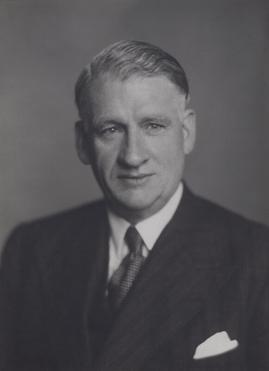Related Research Articles

British Steel was a major British steel producer. It originated from the nationalised British Steel Corporation (BSC), formed in 1967, which was privatised as a public limited company, British Steel plc, in 1988. It was once a constituent of the FTSE 100 Index. The company merged with Koninklijke Hoogovens to form Corus Group in 1999.
The British Transport Commission (BTC) was created by Clement Attlee's post-war Labour government as a part of its nationalisation programme, to oversee railways, canals and road freight transport in Great Britain. Its general duty under the Transport Act 1947 was to provide an efficient, adequate, economical and properly integrated system of public inland transport and port facilities within Great Britain for passengers and goods, excluding transport by air.

The National Coal Board (NCB) was the statutory corporation created to run the nationalised coal mining industry in the United Kingdom. Set up under the Coal Industry Nationalisation Act 1946, it took over the United Kingdom's collieries on "vesting day", 1 January 1947. In 1987, the NCB was renamed the British Coal Corporation, and its assets were subsequently privatised.
The British Electricity Authority (BEA) was established as the central British electricity authority in 1948 under the nationalisation of Great Britain's electricity supply industry enacted by the Electricity Act 1947. The BEA was responsible for the generation, transmission and sale of electricity to area electricity boards, and the development and maintenance of an efficient, coordinated and economical system of electricity supply.
The United Kingdom Central Electricity Board (CEB) was established by the Electricity (Supply) Act 1926. It had the duty to supply electricity to authorised electricity undertakers, to determine which power stations would be 'selected' stations to generate electricity for the board, to provide main transmission lines to interconnect selected stations and electricity undertakers, and to standardise generating frequency.
The Electricity Commissioners were a department of the United Kingdom government's Ministry of Transport, which regulated the electricity supply industry from 1920 until nationalisation in 1948. It was responsible for securing reorganisation on a regional basis and considered schemes for centralisation in a small number of large generating stations owned by joint electricity authorities.

Clement Attlee was invited by King George VI to form the Attlee ministry in the United Kingdom in July 1945, succeeding Winston Churchill as Prime Minister of the United Kingdom. The Labour Party had won a landslide victory at the 1945 general election, and went on to enact policies of what became known as the post-war consensus, including the establishment of the welfare state and the nationalisation of some industries. The government's spell in office was marked by post-war austerity measures, the violent crushing of pro-independence and communist movements in Malaya, the grant of independence to India, the engagement in the Cold War against Soviet Communism as well as the creation of the country's National Health Service (NHS).

The Electricity Act 1947 was an Act of the Parliament of the United Kingdom which nationalised, or bought into state control, the electricity supply industry in Great Britain. It established a central authority called the British Electricity Authority (BEA) to own and operate all public electricity generation and transmission facilities and created 14 area electricity boards with a duty to acquire bulk supplies of electricity from the central authority and to distribute and sell electricity economically and efficiently to industrial, commercial and domestic consumers. It vested 505 separate local authority and company owned electricity undertakings in the BEA with effect from 1 April 1948. The Electricity Act 1947 is one of a number of Acts promulgated by the post-war Labour government to nationalise elements of the UK’s industrial infrastructure; other Acts include the Coal Industry Nationalisation Act 1946; Transport Act 1947 ; Gas Act 1948; and Iron and Steel Act 1949.

The North Thames Gas Board was an autonomous state-owned utility area gas board providing gas for light and heat to industries, commercial premises and homes in south-east England. The board's area of supply, encompassing 1,059 square miles (2,740 km2), included parts of the County of London, Berkshire, Buckinghamshire, Essex, Hertfordshire, Middlesex and Surrey.

Alfred Edwards was a British politician who served for fifteen years as a Member of Parliament (MP). His origins were as a company director in the foundry industry in Middlesbrough, which led him into conflict with the Labour Party when it proposed to nationalise the iron and steel industries; profoundly unable to support the party, he crossed the floor and became an active Conservative Party supporter.
The Iron and Steel Corporation of Great Britain was a nationalised industry, set up in 1949 by Clement Attlee's Labour government.

Rochdale was, from 1856 to 1974, a local government district coterminate with the town of Rochdale in the northwest of England.

The Coal Industry Nationalisation Act of 1946 was an Act of the Parliament of the United Kingdom which nationalised, or brought into state control, the coal industry in the United Kingdom. It established the National Coal Board as the managing authority for coal mining and coal processing activities. It also initially provided for the establishment of consumers' councils. The Coal Industry Nationalisation Act 1946 was the first of a number of Acts promulgated by the post-war Labour government to nationalise elements of the UK's industrial infrastructure; other Acts include the Electricity Act 1947; the Transport Act 1947 ; the Gas Act 1948; and the Iron and Steel Act 1949.
The area gas boards were created under the provisions of the Gas Act 1948 enacted by Clement Attlee's post-war Labour government. The Act nationalised the British gas industry and also created the Gas Council.

The Gas Act 1948 was an Act of the Parliament of the United Kingdom which nationalised, or bought into state control, the gas making and supply industry in Great Britain. It established 12 Area Gas Boards to own and operate all public gas making, distribution and sales facilities and created a central authority: the Gas Council. It vested the existing local authority and company owned gas undertakings into the Area Boards with effect from 1 May 1949. The Gas Act 1948 was one of a number of Acts promulgated by the post-war Labour government to nationalise elements of the UK's industrial infrastructure; other Acts include the Coal Industry Nationalisation Act 1946; the Electricity Act 1947; Transport Act 1947 ; and the Iron and Steel Act 1949.
The Gas Council was a UK government body that provided strategic oversight of the gas industry in England, Wales and Scotland between 1949 and 1972.

The Iron and Steel Act 1949 was an Act of the Parliament of the United Kingdom which nationalised, or bought into state control, elements of the iron and steel industry in Great Britain. It established an Iron and Steel Corporation which acquired certain iron and steel companies. In a departure from earlier nationalisations the Corporation only acquired the share capital of the companies, not the undertakings themselves. The individual companies continued to operate under management Boards appointed by the corporation. The Iron and Steel Act 1949 was one of a number of Acts promulgated by the post-war Labour government to nationalise elements of the UK's industrial infrastructure; other Acts include the Coal Industry Nationalisation Act 1946; the Electricity Act 1947; Transport Act 1947 ; and the Gas Act 1948.
The Macclesfield group power stations are three relatively small electric power stations at Alderley Edge, Buxton, and Macclesfield, England. They supplied electricity to their respective towns from 1890s to the 1960s. The oil-engine stations were operated by a succession of private and public owners prior to the nationalisation of the British electricity industry in 1948. The power stations were redeveloped as a group in the 1950s as demand for electricity grew and old plant was replaced.
St Helens power station supplied electricity to the Borough of St Helens and the surrounding area from 1896 to the late 1960s. The power station was developed by the St Helens Corporation which operated it up to the nationalisation of the British electricity supply industry in 1948. It was redeveloped several times to meet the increased demand for electricity.
References
- ↑ "Iron and Steel Board". The Times. 6 September 1946. p. 4.
- 1 2 "End of Iron and Steel Board". The Times. 1 October 1948. p. 4.
- 1 2 3 4 5 6 "Records of the Iron and Steel Corporation of Great Britain, the Iron and Steel Board, and related bodies". The National Archives. Retrieved 13 March 2023.
- ↑ Kelf-Cohen, Reuben (1973). British Nationalisation 1946-1973. Macmillan. ISBN 9781349015436.
- 1 2 "Iron and Steel Corporation of Great Britain, 1946-1967". Modern Records Centre. Retrieved 13 March 2023.
- 1 2 "The Board that couldn't quite...". The Times. 3 July 1968. p. 23.
- ↑ Hansard House of Commons Debates 21 May 1953 vol 515 cc2268-72
- ↑ "New chairman of Steel Board". The Times. 22 December 1958. p. 8.